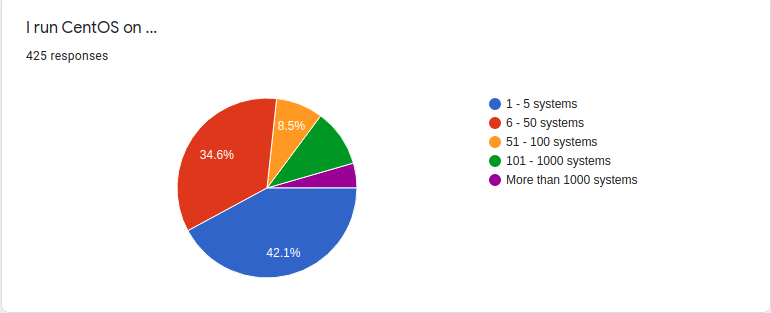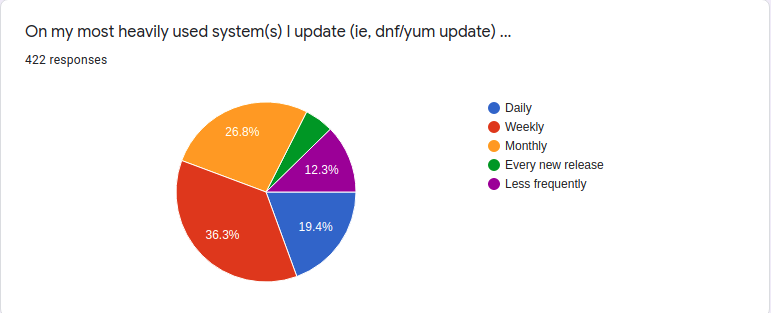Over the past several months we have been running a user survey to learn more about how CentOS is used. This was a very short survey - 4 questions - designed to give us a very high-level view of how the community breaks down in terms of usage. We hope that next year we can expand on this and get more detail.
There were 426 responses to the survey, with 96 of those individuals indicating that they would be open to us contacting them for more detail about their answers.
Without further introduction, here are the answers. (Note: we did an early report on results 2 months ago, and results have not changed significantly since then.)
Question 1: What we use it for.
Note: Percentages do not add up to 100% because multiple responses were allowed.
- Professional software development: 30.4% (129 responses)
- Personal/Hobby software development: 31.1% (132)
- Running services for a job/company: 62.6% (266)
- Running services for personal/home use: 62.8% (267)
- Desktop computer 27.5% (117)
Takeway: CentOS is still used primarily as the workhorse on which you run your network services, both at work and at home, but using it as a software development platform is a strong second. Lots of alternate answers entered under "Other" were almost all just rephrasings of the above categories.
Question 2: Volunteerism
This question asked where participants would be interested in volunteering. Approximately half of respondents skipped this question.
- Testing: 58.4% (132)
- Packaging: 37.6% (85)
- Design: 15.5% (35)
- Promotion: 22.1% (50)
- Event planning: 5.3% (12)
Takeaway: A lot of you want to help with testing and packaging. Why aren't you? This probably indicates that our onboarding documentation/process around the testing/qa effort needs a lot of improvement, and that we need to do a better job of pointing people to packaging opportunities like SIGs and EPEL. Those of you who want to help with design and promotion, please join us on the centos-promo mailing list!
Question 3: Size of installation
In this question we offered some very broad categories of installation sizes to get an idea of whether you're running this on a single machine or a cluster of thousands.
- 1-5 systems: 42.1% (179)
- 6-50 systems: 34.6% (147)
- 51-100 systems: 8.5% (36)
- 101-1000 systems: 10.4% (44)
- 1000+ systems: 4.5% (19)
Takeaway: While most of our fascinating stories tend to focus on the massive installations - the supercomputing clusters and massive social networks of the world - the overwhelming majority of users are smaller installations in the 1-50 systems range.
Question 4: Update frequency
With this question we were trying to get a clearer idea of how important frequent updates are - how often do you consume new packages with a dnf update
- Daily - 19.4% (82)
- Weekly - 36.3% (153)
- Monthly - 26.8% (113)
- New releases - 5.2% (22)
- Less frequently - 12.3% (52)
Takeaways: Almost all of you update at least monthly, with more than half of you updating at least once a week. We think this means that regular updates are pretty important to you. We're fascinated with the 12% of you who install a system and then leave it running with no updates.
What did we learn?
The biggest thing that I learned from this is that there's a lot of you out there that want to help and don't know what opportunities are available. We obviously need to do a much better job of telling you about those opportunities.
There's so much more that we wanted to ask, but we know that surveys are annoying, and you get a million of them every week. We do intend to do more of these in the future, but will try to do them in such a way that they are as uninavasive as possible, while giving the opportunity for those of you who want to tell us more, to do so.
Those of you who indicated that we can contact you to ask more - we're still trying to figure out what we want to ask you. Thanks for your willingness and your patience. You'll hear from us in the coming months.




FYI: I used to run a cluster in the 51-100 node range and we latterly updated monthly when system time was taken. Earlier we were in your 12% group, simply because there was no way to connect the systems to the internet and downloading a complete distribution (Cemtos, EPEL, Elrepo and Nux) to a stack of CDs at home over slow "broadband" was time-consuming. Indeed when I first ran a CentOS system I didn't have broadband at home so updates were never.
Where do I subscribe to be notified when you do the next one of these?
Scott, I'll announce it in all the places - https://twitter.com/centosproject and https://www.facebook.com/groups/centosproject and https://www.reddit.com/r/CentOS/ and https://blog.centos.org and the various mailing lists. If you're following us anywhere, you should see it mentioned.
Could we have a suggestion scheme or other feedback mechanism built into CentOS itself? Perhaps while waiting for packages to install or update? At least there could be an option to report any issues when using primary public package repositories. Opt-in anonymous usage stats are also great for steering improvement initiatives.
Karl: There are two answers to these kinds of enhancement requests.
1) We just ship what RHEL ships, and so can't really add enhancements into CentOS itself, except by going through RHEL channels.
2) These kinds of enhancements might be a good target for a SIG, to build something layered on top of CentOS. https://wiki.centos.org/SIGGuide/
Comments are closed.